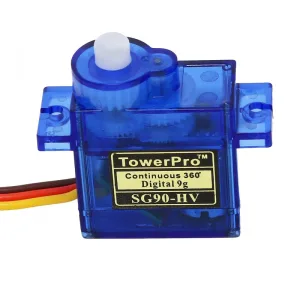Continuous Servos
Continuous Servos

Continuous Servo and DC Motor are both commonly used for robotic applications, but they have different characteristics and are suitable for different purposes.
Advantages of Continuous Servo
- Speed and Direction Control: A continuous servo allows precise control over both speed and direction of rotation. By adjusting the input signal, you can make the servo rotate at different speeds and change direction easily.
- Simplified Control: Continuous servos typically have built-in control circuitry that eliminates the need for complex motor control circuitry. They are designed for easy integration and straightforward operation.
- Position Feedback: Some continuous servos come with built-in position feedback in the form of an internal potentiometer. This allows you to know the exact position of the servo, which can be useful in certain applications.
- Easy to Interface: Continuous servos often use standard servo connectors, making them compatible with a wide range of controllers and microcontrollers without requiring additional interface circuitry.
Disadvantages of Continuous Servo
- Limited Precision: Continuous servos are not designed for precise positioning. The absence of a feedback mechanism for positioning means they may not be suitable for applications requiring high positional accuracy.
- Limited Torque: Continuous servos generally have lower torque compared to DC motors of similar size. This can restrict their use in applications requiring high torque.
- Higher Cost: Continuous servos are usually more expensive than standard DC motors, mainly due to the added control circuitry and features.
DC Motor
DC Motor
Advantages of DC Motor

- High Torque: DC motors are known for their high torque capabilities. They are suitable for applications that require significant power output.
- Cost-effective: DC motors are widely available and generally more affordable than continuous servos, making them a cost-effective choice for many applications.
- Wide Range of Sizes and Types: DC motors come in various sizes, power ratings, and types, allowing you to choose the one that best suits your specific application requirements.
- Customizability: DC motors can be easily customized by adding gears or other mechanisms to achieve the desired torque, speed, and direction of rotation.
Disadvantages of DC Motor
- Speed and Direction Control: Unlike continuous servos, DC motors do not have built-in control circuitry for speed and direction control. Additional motor control circuitry, such as an H-bridge, is required for precise control over speed and direction.
- Position Control: DC motors do not have inherent position feedback, making it challenging to achieve precise positional control without the addition of external sensors or encoders.
- More Complex Control Circuitry: Controlling a DC motor for speed and direction requires additional circuitry, such as motor drivers or H-bridges, which increases complexity and cost.
Ultimately, the choice between a continuous servo and a DC motor depends on the specific requirements of your robotic application. If you need precise control over speed and direction with simplified control and position feedback, a continuous servo might be more suitable. On the other hand, if you require high torque, cost-effectiveness, and customization options, a DC motor might be the better choice.